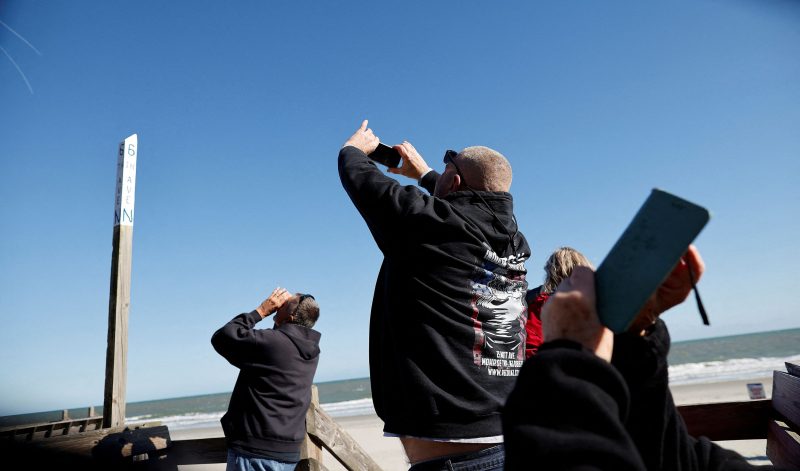In mid-June 2020, as attention in the United States was directed elsewhere, northern Japan was captivated by a new mystery: What was that thing in the sky?
A large white object was spotted by residents of the country’s Miyagi and Fukushima prefectures before it drifted behind cloud cover. “Television footage taken in the northeastern city of Sendai,” one news report explained, “showed a balloon-like object above a cross, on which propellers seemed to be turning.”
A balloon-like object in the sky over northern Japan set social media ablaze. The debate became the third most trending topic pic.twitter.com/fqFMjFhrjz
— Reuters (@Reuters) June 18, 2020
The release of footage of unidentified flying objects by the U.S. Air Force a few months before led to contemporaneous speculation that the object was perhaps extraterrestrial. When considered in February 2023, though, a more likely possibility springs to mind.
Was this an early iteration of the sort of Chinese surveillance balloon that drifted over the United States last week?
The balloon over Japan (a nation that lies just to the east of China) burst soon after it was noticed, leaving behind a “puff of smoke.” Last week’s iteration was more robust, reaching its demise off the Eastern Seaboard thanks to a well-targeted Sidewinder missile — but with a result that might be described the same way. The Biden administration insists that the flyover yielded valuable information for U.S. intelligence officials, though it has also been fending off harsh criticism from Republicans insisting that the object should have been dispatched before reaching U.S. airspace (though the device’s flight path brought it over Canada before reaching northern Idaho).
Military officials also made another remarkable assertion that stands as a rejoinder to Republican criticism, intentionally or not: There were also balloon overflights during the Trump administration.
On the social media platform he owns, Donald Trump denied this, as did more credible officials within his administration. The Washington Post’s Dan Lamothe and Azi Paybarah, however, report that the discovery of those previous overflights reportedly only occurred after Trump left office.
“The official did not explain how the information about the earlier balloons came to light,” they wrote, “or if intelligence gleaned from the one tracked by the U.S. military over the last week played a role in better understanding China’s surveillance efforts.”
The first mention of these previous flights came Feb. 2, in a statement from Air Force Brig. Gen. Pat Ryder, the Pentagon press secretary.
“Instances of this kind of balloon activity have been observed previously over the past several years,” a statement from Ryder said.
After the balloon was shot down, a news release from the Defense Department offered more details: “Chinese balloons briefly transited the continental United States at least three times during the prior administration.” Other reports suggested that some of those flights were over or near Texas and Florida (it’s not clear which). Such proximity to the southern United States is perhaps not surprising, given that China has admitted ownership of another balloon that was seen recently near Costa Rica. There were also reports about overflights in other places: near Hawaii on multiple occasions, for example, or (as The Post reported) over Guam.
One reason that past flights might not have been identified as a function of Chinese surveillance is that there are a number of nongovernment actors releasing balloons that are spotted by civilian observers.
In September 2017, for example, people in South Dakota noticed a balloon, with the Argus Leader reporting that it appeared to originate near the headquarters of a company called Raven Industries — a firm that builds stratospheric balloons for organizations including NASA and a Google initiative, Project Loon, that would use hovering balloons to provide internet access to remote areas.
Another balloon spotted in July 2019 was also linked to Raven Industries.
Anybody else see the glowing circle in the sky over Sioux Falls, SD at dusk tonight? Might be a weather balloon. What do you think?
First image – no edit
Second image – cropped and smoothed #ThePhotoHour pic.twitter.com/lZHj9RlHCJ
— Jon Klemme (@JonKlemme) July 19, 2019
There are also nearly 100 weather balloons released by the National Weather Service each day in the United States and its territories to track weather patterns. But those balloons are also tracked. So, when in June 2019 several balloons were observed over Kansas City, Mo., the NWS could assert that the devices were not theirs.
Google also denied that the Kansas City balloons belonged to them. The local Fox affiliate suggested that they might be related to experiments being conducted out of Maryland by the Defense Advanced Research Projects Agency, but this wasn’t confirmed. In the same period, there were similar objects spotted over Dayton, Ohio. Officials at Wright-Patterson Air Force Base denied responsibility, as did another regional business that produced such balloons.
Every so often, similar questions emerge on social media, like this one from late 2019 near El Paso. What is this thing?
I saw this in the sky yesterday around sunset. Couldn’t tell what it was until I took a picture of it. Weather Balloon??#weather-balloon #txwx #StormHour pic.twitter.com/F2rVC0L9pN
— Jose Sarinana (@_FirNaTine_) December 17, 2019
One would think that the government has a good sense of where and when these objects are appearing in our skies, but that’s probably not possible. The object above, for example, is similar to the sort of homemade observational experiment that we documented last week, the deployment of a large balloon to capture images that is not uncommonly undertaken as a science class experiment for students.
As The Post’s David Ignatius notes, however often there might have been foreign balloons floating over the United States, the most recent excursion was neither cursory nor subtle. It’s possible, as Lamothe and Paybarah report, that this flight allowed the United States to better understand how these surveillance balloons work and therefore answer questions about objects that had been observed in the past — including the times Trump administration officials didn’t know that these apparent overflights were happening.
Trump’s assertion on his social media network that “the Chinese would never have floated the Blimp (‘Balloon’) over the United States if I were President!!!,” however, is less tenable.
Update: Reporting from Bloomberg confirms that the presence of balloons near American territory and facilities during the Trump administration was only determined after the fact.








